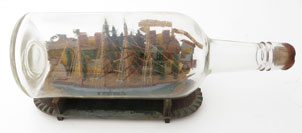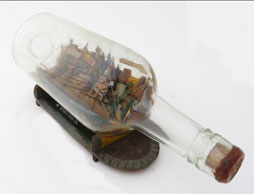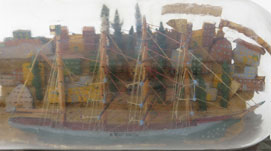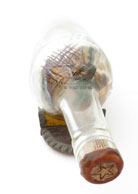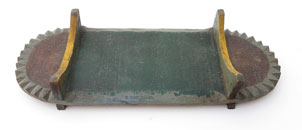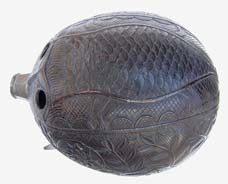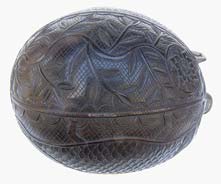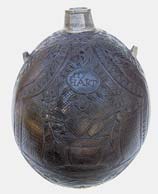SAILOR FOLK ART
Catalog Page 11
When no price is shown, use
Click on photos for larger images.
Click
![]() for ordering details.
for ordering details.
|
PERSPECTIVE
|
SHIP
|
STOPPER
|
STAND
|
|
11.31 CAT O’ NINE TAILS.
Very scarce! Genuine late 18th or very early
19th century sailor-made device used to inflict punishment
on recalcitrant sailors in the early days of sail.
This fearsome yet artistic example is beautifully
macraméd of heavy cotton line using a variety of
fancy knotwork methods including 3 Turk’s heads,
Spanish hitching and 4-strand sennet. It terminates in
a 5 strand Turk’s head with remnants of 4 of the 5 “tails”
still remaining. It is likely that this rare example
is actually what was known as a “boy’s cat.”
(See below). The body measures 12 ½ inches long
by 2 inches wide at the widest and 25 inches long overall
and weighs 5 ounces.
795 |
|
DETAIL
|
VINES
|
MY HEART
|
MOUTH
|
|
11.09 AMERICAN SHIP IN BOTTLE DIORAMA. Good, early 1900’s sailor-made bottle model of a 3-masted bark, which exhibits many of the characteristics sought after by collectors of this folk art form: 1. Clear, clean glass bottle of early form. In short, a very pleasing, original and highly collectible example. The bottle measures 10 inches long by 3 ¼ inches in diameter and the nicely-made solid teak stand measures 11 inches long by 3 inches wide. 349 |
 |
 |
|
|
|
|
STAND |
|
11.25 SHIP IN A BOTTLE DIORAMA. Most charming, early 1900’s ship in a bottle scene depicting a large 3-masterd bark passing a town with numerous features. These include a large windmill, a derrick lifting a load of lumber on the shoreline, a truss bridge over a river, a town in the hills complete with church tower, and a train on tracks running into a tunnel! The ship itself has a raised focsle and poop carved from a single piece of wood. Portholes are depicted along it sides, and it is complete with standing rigging. The ship plies a blue putty sea and the inside of the bottle has a painted blue sky with clouds. This is all contained within an early molded whiskey bottle with long neck sealed with the original cork under old red paint. The glass is clear, the colors bright and the contents are untouched. 11 ¼ inches long by 3 inches in diameter. 395 |
|
PERSPECTIVE
|
DETAIL
|
SHIP/TRAIN
|
|
11.24 SHIP’s RUM DIPPER. Rare! Authentic mid-19th century shipboard grog dipper as used by sailing ship crews in the 1700’s and early 1800’s. This genuine example consists of a classic coconut bowl fitted with a pewter connector by means of three rivets. It fastens to a turned tropical hardwood handle which terminates in a decorative acorn-like finial. The bowl of the dipper is nicely rounded with a deeply incised line around its entire circumference. It measures 3 ½ inches across at the mouth and 3 ¾ inches high. The handle is 11 inches long. The overall measurement is 15 inches. Outstanding original condition with no flaws and showing great age. A super nice relic from the days of sail! 495 |
|
REVERSE
|
BOWL
|
DETAIL
|
|
11.23 UNUSUALLY FINE DOMINO
SET. Especially fine 19th century game
set comprising of a full set of 28 ebony and ivory “double
sixes” dominoes. This unusually handsome set has
bold black markings highlighted with incised red borders on
each piece. The large game pieces measure 2 inches
long by 1 inch wide and are ½ inch thick. They
are made of sandwiched layers of ivory and ebony connected
with a central brass rivet. The entire set fits neatly
into its original dovetailed wooden box with sliding
lid. It measures 7 ¾ inches long, by 2 ½
inches wide and high. Outstanding original condition
showing good age but no abuse. |
|
BOX
|
CONTENTS
|
DETAIL
|
|
11.73 P.O.W. BOX. Rare late 18th or very early 19th century box as made by French prisoners in British prisons during the Napoleonic Wars. This example of P.O.W. straw work consists of a lidded box made of high quality rag or vellum paper, meticulously overlaid by marquetry straw work in a checkerboard pattern on the top surrounded by parallel bands on the top and sides. Contained within is an early, period mirror with telling irregular striations in the glass, surrounded by a hand-punched decorative foliate paper border. This diminutive box measures 2 1/2 by 3 1/2 inches and is one inch thick. It is in a remarkable state of original preservation given its age and the fragile material from which it is constructed. As such it represents a very rare surviving form of the prisoners' output. 195 |
|
11.04 P.O.W. GAMEBOX. Authentic late 18th or very early 19th century “game casket” made by French prisoners in British prisons during the Napoleonic Wars. This fine example is constructed entirely of beef bone and wood, with colored paper and even some genuine gold foil! The box, in the form of a 4-poster bed with bone columns, is finely constructed of pine with pinned and dowelled fittings. Overlaying the wooden structure the entire surface is covered by meticulously carved bone panels done with incredible detail. These are affixed in the classic manner with scores of metal rivets! The sliding lid is “domed” and decorated with reticulated bone panels overlying green paper and two “clubs” of gold. All four sides of the box are decorated in a similar manner with “sashes” and recurring designs. The interior of the box is divided into 3 compartments. The largest houses a full set of 55 double nines bone domino pieces! The second holds hand-painted bone playing cards of which there are more than 25 pieces. The third compartment holds bone die. This rare set measures 9 inches log, 3 ½ inches wide and 2 ¼ inches high. The entire presentation is in a remarkable state of original preservation considering the delicacy of its construction and its 200 plus years. 2295 |
|
11.19 SAILOR'S NEEDLE CASE. Extra large 19th century sailmaker's needle case. This very fine example of working sailor folk art consists of a carved wooden tube with a matching "plug" cap which joins with a tight press fit. Over each is meticulously woven decorative Spanish hitching done in traditional sailor fashion known as McNamara work or "macramé." Such a covering was functional, providing a wear resistant, easily gripped covering which also spoke of the sailor's abilities as an accomplished seaman. This extra large specimen measures 8 ½ inches long by 1 ½ inches in diameter and is complete with 2 old sail canvas needles. One is triangular-shaped with English markings and the other has an unusual curved “spade” shape. Excellent original condition with a deep, rich old shellacked surface. A very handsome deck hand's needle case from the days of sail. Certainly one of the nicest examples currently on the market. 395 |
|
|
11.92 SEAM RUBBER. Nicely carved 19th century solid rosewood sail maker's seam rubber. This working sailor's tool has a faceted diamond shaped handle which gives way to an octagonal shaft terminating in a broad tapered blade. The shaft has distinctive raised "nibs" where it meets the blade on each side. 4 1/2 inches long by 2 1/4 inches wide. Outstanding original condition with a deep age patina. 695
This is the exact seam rubber pictured on page 126 of Norman Flayderman's book, "Scrimshaw and Scrimshanders, Whales and Whaleman." We will document this fact in writing to the purchaser.
|
|
|
|
|
|
|
|
11.51 FOLK ART CARVING. Incredible 19th century whimsy carved from a single block of wood. This outstanding example of the carver's art depicts a hook and eye attached to a "capture ball" encased in a cage which is is attached to another eye carved with a large circular ring. The amazing aspect of this carving is that it is fashioned from a single piece of pine, requiring both planning and skill to execute in such a detailed manner. The carving measures 10 1/2 inches long and is in outstanding original condition with an excellent oxidized natural wood finish with beautiful patination. 195
|
|
11.94 SAILOR'S NEEDLE CASE. Huge 19th century sailmaker's needle case. This exceptionally large example of working sailor folk art consists of a carved wooden tube with a matching "plug" cap which joins with a tight press fit. Over each is meticulously woven decorative Spanish hitching done in traditional sailor fashion known as McNamara work or "macramé". Such a covering was functional, providing a wear resistant, easily gripped covering which also spoke of the sailor's abilities as an accomplished seaman. This amazing example measures 9 1/2 inches long by 1 3/4 inches in diameter and is complete with 2 old triangular-shaped heavy sail canvas needles, both with English markings. Excellent original condition with a rich old surface. A simply great deck hand's needle case from the days of sail! The largest example we have ever seen. 495
|
|
|
|
|
|
11.75 SEAM RUBBER. Nicely carved mid-19th device used by a sailor to crease a fold in sail cloth prior to stitching. This genuine sailmaker's tool is fashioned from a single piece of oak with an octagonally-faceted shaft, tapered "blade" and rounded knob. It is rich with wear and patina attesting to years of actual use aboard a sailing ship. 4 1/2 inches long. A "living" piece of sailing history. 195
|
|
|
|
Also see catalog pages 2, 4 and 20 for more sailor-made folk art
items
 |
 |
 |
 |
 |
 |
 |
 |
 |
 |
 |
 |
 |
 |
 |
 |
 |
 |
 |
 |
 |
 |
 |
 |
 |
 |
© 1998-2014 West Sea Co. All rights reserved.
